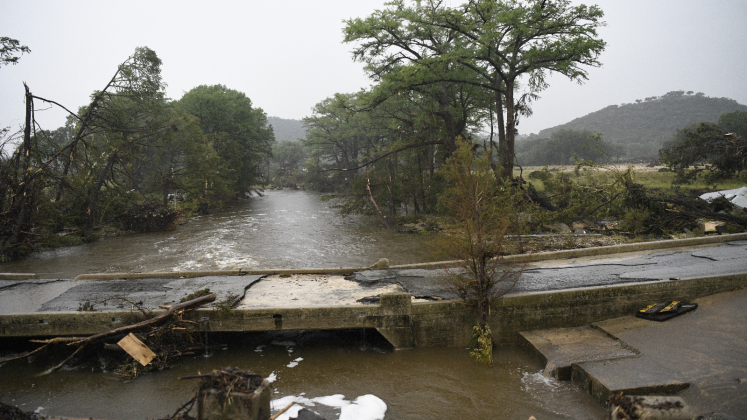On the night of July 4, 2025, torrential rain fell over Texas Hill Country, turning the Guadalupe River into a deadly torrent. By early morning, the river had risen over 26 feet in less than an hour, sweeping away cabins at several summer camps and claiming at least 111 lives, among them 27 children and staff at Camp Mystic. This catastrophe, the deadliest U.S. weather-related disaster of the year, was not caused by a failure to forecast. It was a failure of communication, preparation, and foresight, especially at the so-called “last mile” of risk messaging.
What is most haunting about this disaster is how much was expected, and yet how little was done. The National Weather Service issued 22 warnings in the hours leading to the flood. The science worked. Forecasting models were reasonably accurate. Radar captured the extreme rainfall in real time. But Kerr County never activated its CodeRED system. No emergency push alerts came from local authorities. No sirens wailed in the night. Most victims were asleep, their phones silenced, unaware that the river just feet from their cabins had turned lethal. In a region often referred to as “Flash-Flood Alley,” a modern, automated siren and sensor network might have saved dozens of lives. That network does not exist in Kerr County because officials repeatedly chose not to build it.
This absence was not an oversight. For nearly a decade, county commissioners debated installing a $1 million flood alert system with upstream gauges and sirens. The idea was opposed due to its cost and concerns that sirens would disrupt the rural “peace and quiet.” Public records show that proposals were tabled repeatedly. Even after a federal hazard mitigation grant was offered, the county let the application expire. The final decision came down to aesthetics and dollars, not science or safety.
Summer camps, too, relied on outdated systems. At Camp Mystic and others, the primary flood alert method was a phone chain known as “river calling,” a tradition dating back to the 1950s. It depended on someone upstream seeing the flood and calling those downstream, an approach that fails in a world of rapid-onset night-time floods. With riverbanks saturated and phones unable to ring through Do Not Disturb settings, the warning chain broke. By the time the counselors realized the danger, the water had already breached the lower cabins, some of which had been built directly on the floodplain.
The tragedy is compounded by déjà vu. In 1987, ten teenagers died in a night-time flood on the same river, under strikingly similar conditions. Afterward, officials called for the implementation of warning systems, the updating of safety standards, and structural changes. But those lessons were never fully translated into regulatory requirements or enforced through licensing or accreditation. When the rain returned nearly four decades later, so did the same fatal vulnerabilities.
Most surprising is the policy failure at the state level. Just weeks before the flood, the Texas legislature considered House Bill 13, which proposed a state-funded grant program to support outdoor warning systems in high-risk counties. The bill failed over cost objections. Then came the Kerr County disaster: a tragic reminder that the cost of prevention is not only far less than the cost of response and recovery, but pales in comparison to the irreversible cost of lost lives.
If we are to prevent future tragedies, we must finally treat flood risk communication as a critical part of infrastructure. Localities with known exposure must be required to install multi-channel alert systems that include sirens, satellite-based text alerts, and real-time river-gauge automation. Camps, RV parks, and overnight facilities in flood-prone areas must follow stricter setback and elevation rules. Safety plans must include mandatory nighttime evacuation drills, and compliance should be tied to licensing and accreditation. A rural hazard mitigation fund must be established to remove financial barriers to installing essential alert systems, ensuring that local budget politics do not decide who lives or dies.
This tragedy highlights a broader lesson in flood risk management: predictive science alone cannot protect communities without robust, locally implemented communication infrastructure and preparedness protocols. Accurate forecasts must be translated into immediate, actionable warnings that reach every person at risk, especially the most vulnerable, such as children asleep in flood zones. The Texas flood revealed a persistent disconnect between scientific capability and policy execution, a gap often widened by funding barriers, political inertia, or misplaced priorities. If science is to serve public safety, it must be paired with clear institutional responsibility, sustained investment in early warning systems, and policies that treat risk communication as essential infrastructure, not optional add-ons. The implications extend far beyond Kerr County: as climate change accelerates the frequency and intensity of flash floods, communities nationwide must reexamine not only how they predict hazards, but how they respond when those predictions arrive. The science was clear. The forecast was accurate. But the sirens stayed silent. Let this be the last time.
Suggested citation: Vahedifard, Farshid, AghaKouchak, Amir (2025). "Catastrophic Texas Flood as Science Warned but Sirens Stayed Silent ," United Nations University, UNU-INWEH, 2025-07-16, https://unu.edu/inweh/article/catastrophic-texas-flood-science-warned-sirens-stayed-silent.


